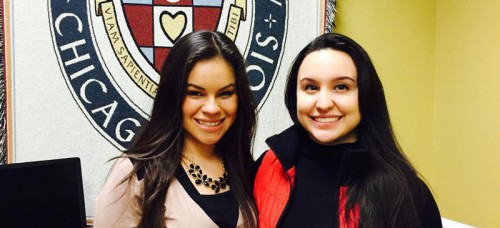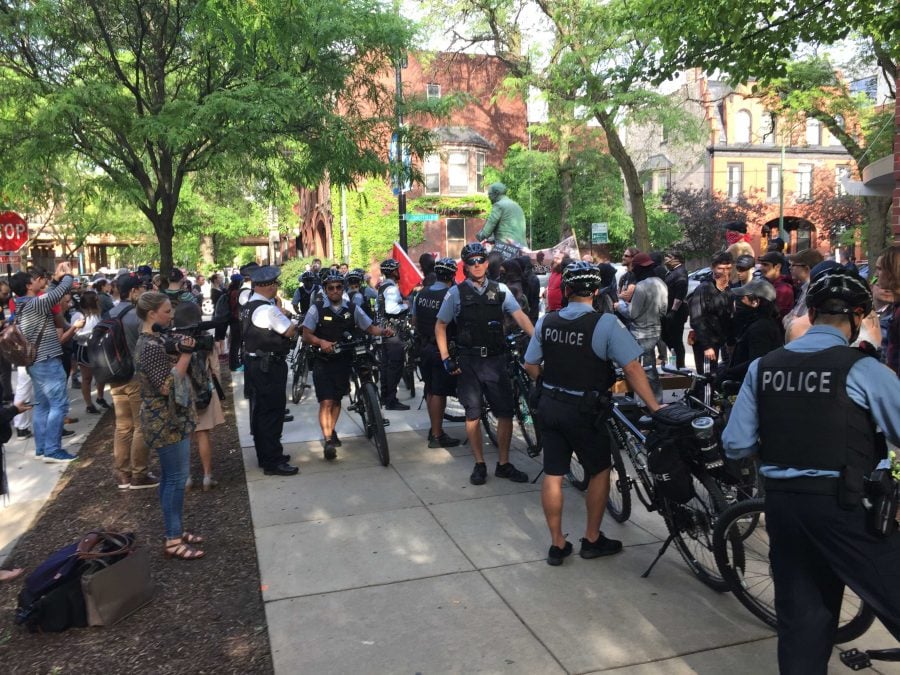
Betzaira Herrera’s mother only received a sixth grade education in Mexico. In order to have a better life, she journeyed to the United States despite not speaking any English. A year later, Herrera’s mother gave birth to her and because of the lifestyle her mother had, she was raised with the idea that “education is the key to success.”
With that in mind, Herrera worked to go to college and eventually ended up at DePaul, where she is expected to graduate in the spring.
Herrera was only able to afford college because of the Monetary Award Program (MAP), which provides grants to college students of low-income backgrounds.
“I think the MAP grants have been really helpful,” Herrera said. “I live with a single mother and she can’t help me at all with college. I’m on my own paying for college but then seeing my way through (school) as well.”
 DePaul senior Cristina Vera, who serves as Vice President of the Student Government Association (SGA), can relate to Herrera because she also has to pay for college herself and receives MAP funding as well. Vera said it has made her feel privileged that she is even able to be at a school like DePaul.
DePaul senior Cristina Vera, who serves as Vice President of the Student Government Association (SGA), can relate to Herrera because she also has to pay for college herself and receives MAP funding as well. Vera said it has made her feel privileged that she is even able to be at a school like DePaul.
“I definitely realize that it’s a privilege I’m here at DePaul and that I’m here at college in general coming from the neighborhood that I do,” Vera said. “I have plenty of family and friends that I know and see that didn’t have the opportunity to go to college or didn’t pursue it in their future.”
Vera chose to attend DePaul because her father had always been interested in going but never went. Because her father was always talking about the university, she did her research and fell in love with it.
When Vera saw the sticker price for DePaul though, she felt intimidated. To fix this, she talked to her high school advisor and sought out other resources that let her know more about financial aid, which eventually led her to MAP.
Although students such as Vera and Herrera have relied heavily on these grants, according to an article in the Chicago Tribune, Gov. Bruce Rauner “can’t maintain or enhance the spending he claims he will maintain or enhance with the tax policy he proposes; one of the two has to give.”
This means that either more money will be put into the health care system and taken out of education, or more of the state’s budget will be put into education and taken out of health care.
Herrera said she would be disappointed if Rauner were to take money out of education because of how much of an impact the grant program has had and continues to have on students.
“Even though I am graduating this year, I think of how helpful MAP grants are for students in my shoes,” Herrera said. “In my neighborhood, (the grants) are a deciding factor as to whether or not (those students) are going to go to one school or another. It’s really disappointing that there are people (like Rauner) who don’t understand how helpful (the grants) are for students.”
Vera agrees with Herrera, saying she would be disappointed in the cuts because MAP is a form of financial aid for a variety of students who would help to build Illinois in the future.
“(MAP cuts) would be detrimental to all of the students who have the potential to pursue higher education or afford a university that (could) fuel Illinois’ work force,” Vera said.
If Rauner were to cut MAP grants, Vera and Herrera both agreed that they would like to see the money be placed into Chicago Public Schools.
SGA President Matthew von Nida said that tuition would go up for DePaul students if Rauner were to go through with some budget cuts in the MAP program because it would “inevitably have to support the recipients who didn’t get their funds.”
As opposed to Rauner, former Gov. Pat Quinn was supposedly trying to propose a $50 million increase in the funding and expand the program to 21,000 more students, according to the Chicago Sun-Times.
Von Nida said the current funds for Illinois are about $400 million, which is a “miniscule” portion of the state budget, meaning Quinn’s proposal would not be a “drastic change.”
According to Herrera, it’s always easier for a person to say they are going to do something than not, which is why she was not sure as to whether she should trust Quinn or not.
Vera, on the other hand, thought Quinn’s proposal would have been very beneficial.
“It’s definitely great that he wanted to double map funding,” she said. “(Quinn) had always shown strong support towards MAP and going to colleges and talking more to students so it was really supportive to see that.”
Because of the vast knowledge Vera and Herrera have of MAP grants, the two said they try to show their own support in the program and give back by being advocates for students that need help in understanding MAP. According to Vera, the way she feels like an advocate is through leading by example and just graduating.
She also is involved in an organization outside of school, the Network for Teaching Entrepreneurship, which is a global organization whose main goal is to teach Chicago Public high school students the profits of going to college.
Herrera said she also tries to lead by example for those around her and in her neighborhood by doing whatever she can to influence or encourage them.
“Sometimes students like (Vera and I) just need to know there is a solution,” Herrera said. “(They) just have to know there will always be people who are interested to help (them) if (they) ask for it.”
Part of the reason that Herrera thinks she needs to be an advocate is because she believes resources for students have such a tremendous impact. She was able to see the lack of resources she had in her school in a predominantly Hispanic neighborhood with low income and high rates of violence and gangs. Herrera noticed the difference in resources that her grammar school had when she attended Whitney Young, a selective enrollment high school.
Herrera was one of the few from her neighborhood to attend one of the few selective enrollment high schools in the city. Seeing the differences made her question why there was a lack of equality between the schools.
“(I didn’t understand) why it was that my neighborhood high school (couldn’t) get the same resources that Whitney Young had,” Herrera said. “Why is it that my friends couldn’t get the same opportunities I had just because of the high school I was placed in?”
It is because of this noticeable difference for Herrera that her advice to students in low-income areas is to always look for the right resources and to never give on the their dream of pursuing a higher education.
“Asking for help isn’t really a big thing,” Herrera said. “You’re on your own (but) try to figure it out as much as possible. Just go on Google and look up scholarships and know it’s possible. Now that I see graduation around the corner, I surprise myself sometimes as well. It all seemed like a dream before and seemed kind of impossible. Seeing the money can be intimidating at first, but once you educate yourself, you know that there’s hope and there are people [who want] to help you so just look for that hope.”



